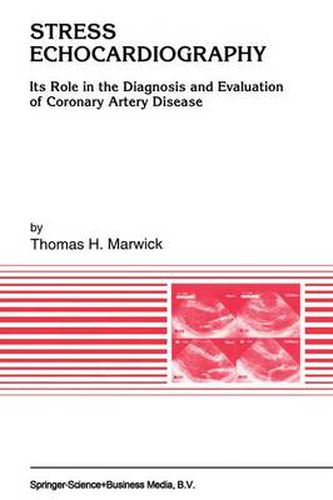Readings Newsletter
Become a Readings Member to make your shopping experience even easier.
Sign in or sign up for free!
You’re not far away from qualifying for FREE standard shipping within Australia
You’ve qualified for FREE standard shipping within Australia
The cart is loading…






This title is printed to order. This book may have been self-published. If so, we cannot guarantee the quality of the content. In the main most books will have gone through the editing process however some may not. We therefore suggest that you be aware of this before ordering this book. If in doubt check either the author or publisher’s details as we are unable to accept any returns unless they are faulty. Please contact us if you have any questions.
W. F. ARMSTRONG While stress echocardiography is not the first technique to be applied to patients for the diagnosis of coronary artery disease, it represents an impor tant clinical tool, likely to become of increasing pertinence in today’s era of cost containment and mandated cost-effectiveness of diagnosis. It may be the most rapidly expanding area of clinical echocardiography today. Stress echocardiography as we know it today represents the natural con clusion and merger of observations made over fifty years ago. In 1935 Tenn ant and Wiggers demonstrated that the immediate result of a coronary oc clusion, was an instantaneous abnormality of wall motion [1]. As viewed from the surface of the heart in an open chest dog preparation, cyanosis and obvious paradoxical bulging of the left ventricular wall was noted. At a similar time Masters and co-workers, using fairly rudimentary exercise de vices, described the response of the human cardiovascular system to sustained exercise (Figure 1) [2]. These two observations diverged for four decades while clinical investigation was pursued along the two parallel lines.
$9.00 standard shipping within Australia
FREE standard shipping within Australia for orders over $100.00
Express & International shipping calculated at checkout
This title is printed to order. This book may have been self-published. If so, we cannot guarantee the quality of the content. In the main most books will have gone through the editing process however some may not. We therefore suggest that you be aware of this before ordering this book. If in doubt check either the author or publisher’s details as we are unable to accept any returns unless they are faulty. Please contact us if you have any questions.
W. F. ARMSTRONG While stress echocardiography is not the first technique to be applied to patients for the diagnosis of coronary artery disease, it represents an impor tant clinical tool, likely to become of increasing pertinence in today’s era of cost containment and mandated cost-effectiveness of diagnosis. It may be the most rapidly expanding area of clinical echocardiography today. Stress echocardiography as we know it today represents the natural con clusion and merger of observations made over fifty years ago. In 1935 Tenn ant and Wiggers demonstrated that the immediate result of a coronary oc clusion, was an instantaneous abnormality of wall motion [1]. As viewed from the surface of the heart in an open chest dog preparation, cyanosis and obvious paradoxical bulging of the left ventricular wall was noted. At a similar time Masters and co-workers, using fairly rudimentary exercise de vices, described the response of the human cardiovascular system to sustained exercise (Figure 1) [2]. These two observations diverged for four decades while clinical investigation was pursued along the two parallel lines.